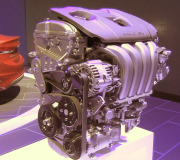You def need someone to take a look at the van with some fresh thinking. Like out of the "Just throw new parts on it" box. It would be helpful to know what codes the van is throwing. If they are generic OBD2 codes, a major parts store can read them for you.
To start with, here is an important item that you did not mention had been done. And one cannot assume it's good without verification. To be sure that the timing belt was re-installed properly after completion of the head gasket replacement. Have someone you trust verify that the camshaft timing is correct. This means that when the #1 piston is at TDC (Top Dead Center), the mark on the camshaft sprocket will be lined up with the mark on the camshaft cover.
To find TDC, the crankshaft is rotated by hand (via a breaker bar & socket on the crankshaft bolt) until the mark on the crankshaft pulley (aka harmonic balancer) lines up with the mark on the lower timing belt cover. This tells you that the #1 piston is at the top of it's stroke. If your engine is now at TDC, the mark (line) on the camshaft sprocket will be in alignment with the mark on the camshaft cover. You will have to remove the upper timing belt cover to expose the camshaft sprocket. If the mark on the camshaft sprocket is 180 degrees off the mark on the camshaft cover, then your not on TDC but rather the #1 piston is at the top of it's stroke on the exhaust stroke. To get from there, to TDC, simply rotate the crankshaft 360degrees (yes the camshaft rotates at1/2 the speed of the crankshaft)
Now when the mark crankshaft pulley is perfectly lined up with the mark on the lower timing belt cover, the mark on the camshaft sprocket SHOULD be lined up with the mark on the camshaft cover.
An additional verification that TDC has been achieved is to check the flywheel position. Remove the timing hole plug (on the top of transmission bell housing on opposite side of crankshaft to where you were just working with the breaker bar) and check the position of the flywheel through this hole. If #1 piston is at TDC (ie on the "power stroke") you will see the mark on the flywheel line up with a mark on the bellhousing.
Another item to check is your coolant temperature sensor (CTS). You have likely had your original "black top" CTS replaced with the newer improved version "green top". Typically, when the CTS goes bad you get a code for it (check engine light) however...I have seen a VR6 engine in a 2002 Jetta that had a CTS go bad in the most unusual way as it caused a miss/sputter. This continued until a hard start condition developed... Then finally a no start condition. All with no codes thrown either which made this no fun at all to diagnose. Anyway, a VAG computer or VAG COM can get a reading of what temperature the CTS is providing the computer... Replace if it's outside the normal range.
Hope this helps...I hate to see a good VW down!
Steve211
Friday, February 6th, 2009 AT 10:53 AM




